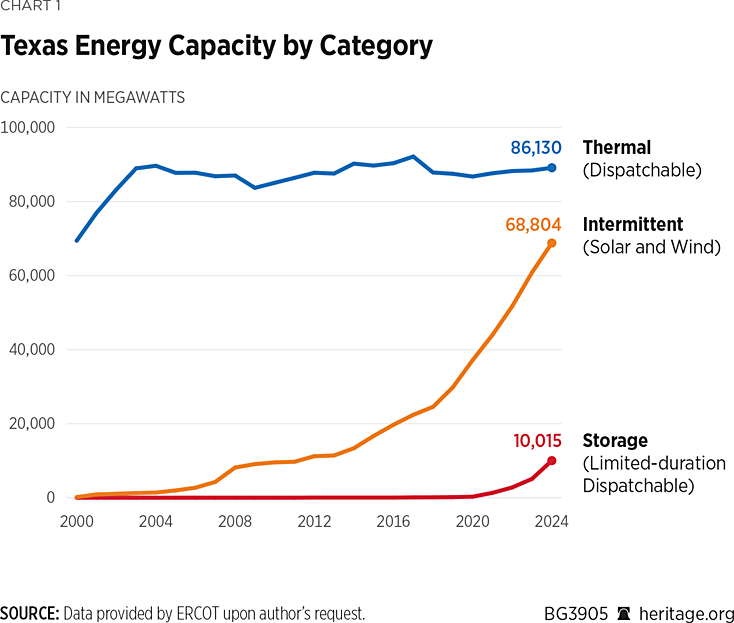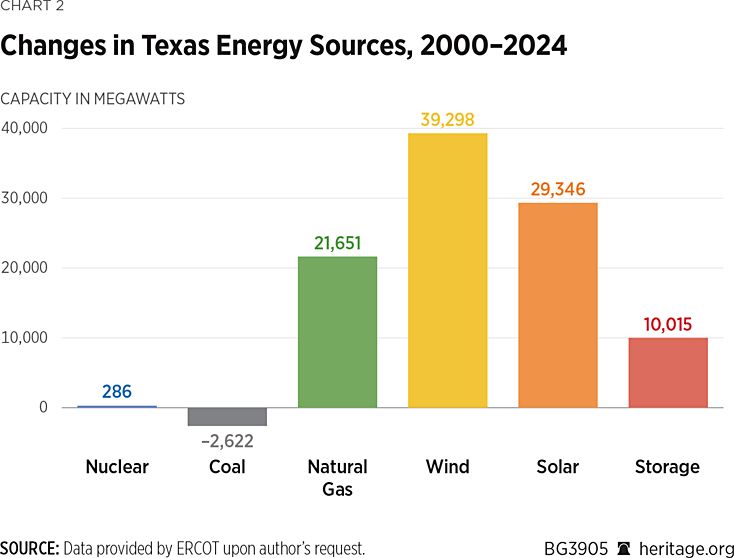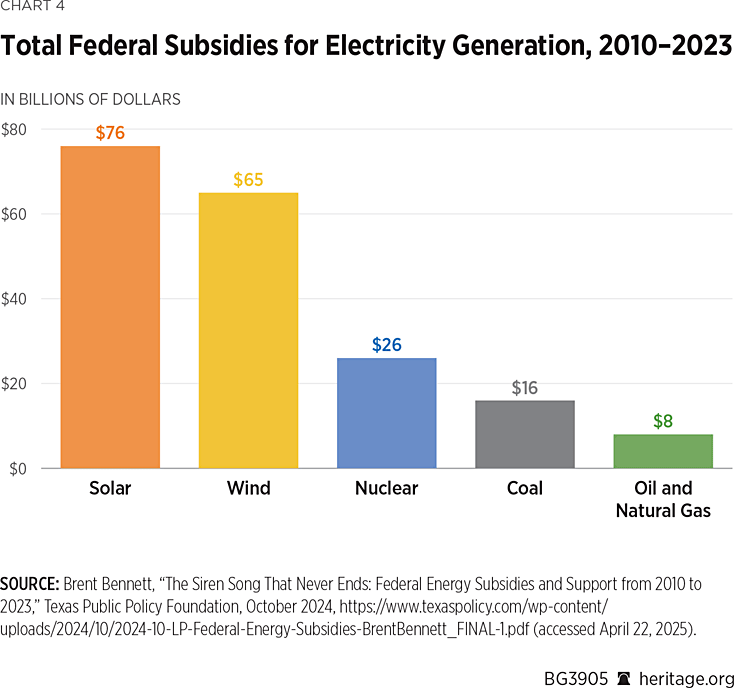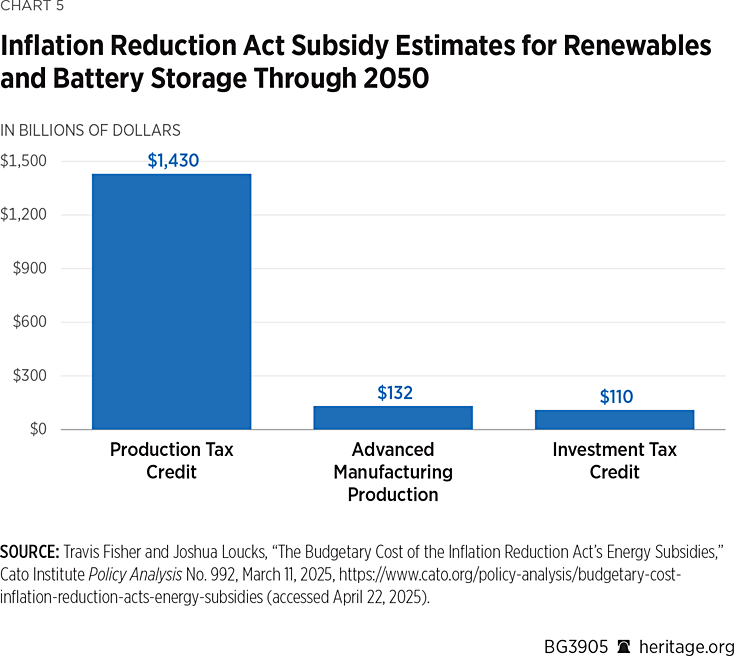Over the past two decades, Texas has greatly expanded its renewable energy capacity. Since 2000, the Electric Reliability Council of Texas (ERCOT) has added nearly 98 gigawatts (GW) of capacity. Of this new capacity, over 70 percent (69 GW) has come from wind and solar farms. In contrast, dispatchable generation—resources capable of adjusting output to meet system demand—has grown by only 30 GW during the same period.REF
Summer peak electricity demand in Texas is projected to grow by nearly 50 GW by the end of the decade, driven by rapid growth of data centers, cryptocurrency mining, and electrification of vehicles and the oil and gas industry.REF Meeting this demand surge will require a substantial buildout of reliable, dispatchable power sources that can maintain supply under all conditions.REF However, most planned capacity additions through the end of the decade remain heavily skewed toward intermittent resources.
ERCOT expects to add about 50 GW of intermittent renewable resource (IRR) capacity—primarily from solar energy—with only an additional 30 GW of dispatchable capacity in the same period. However, the numbers mask a more serious situation. IRRs normally produce only a fraction of their nominal output (also referred to as “nameplate capacity,” the plant’s theoretical maximum output). Solar power, for example, produces an average of just 24 percent of nominal capacity, and cannot be relied on to produce even that much when needed.REF Moreover, nearly 95 percent of this new dispatchable capacity will come from battery storage, which can only sustain output for a few hours. Only 4 GW will come from new natural gas–fired plants, and 2 GW of coal capacity is planned for retirement.REF
To help to address the projected lack of dispatchable power, the previous, 88th, Texas Legislature enacted House Bill (HB) 1500 in 2023. The statute obliges all wind and solar projects that commence commercial operation on or after January 1, 2027, to “firm” their output by securing dispatchable capacity—on site or via contract—sufficient to satisfy performance standards during periods of highest reliability risk.REF
HB 1500 was an important step in the right direction, but it contains three critical shortcomings. First, the standards apply only to new generators that begin operation in 2027 or later, thus excluding the existing generation fleet, whose excess of intermittent resources is already creating grave reliability issues. Second, the law unintentionally advantages battery storage due to generous federal subsidies, creating a skewed investment environment that disfavors more long-duration dispatchable technologies, such as natural gas plants. Finally, Texas should not reward generators for exceeding reliability standards because bonuses would only compound market distortions.
To resolve these flaws, this Backgrounder recommends two key policy reforms. First, the Texas Legislature should extend the reliability standards to all generators with an interconnection agreement, regardless of when they started operating. Senate Bill (SB) 715, authored by State Senator Kevin Sparks (R), would accomplish this by applying the requirements to more than 90 GW of existing wind and solar capacity.REF Second, the legislature should consider neutralizing the distorting effects of federal subsidies by imposing a state-level tax on all energy resources that receive them. This would help to level the playing field among energy sources competing to meet reliability standards. Together, the enactment of these measures would strengthen the reliability of the Texas electric grid.
The Flood of Intermittent Renewables in Texas
Over the past two decades, Texas has rapidly expanded its deployment of intermittent renewable resources. Because solar and wind output varies with weather conditions, these generators cannot reliably meet electricity demand in real time; production can fall steeply—or cease altogether—during cloudless or windless periods. This variability requires greater reliance on load-following dispatchable resources to maintain grid reliability.

Since 2000, approximately 68 GW of wind and solar capacity have been added to the ERCOT grid, as shown in Chart 1. Wind capacity grew at an average rate of about 14 percent per year, reaching 39 GW of nominal capacity by 2024. Since 2010, solar capacity expanded at an average annual rate of 67 percent and totaled 29 GW by 2024.REF
By comparison, long-duration dispatchable capacity has seen a net change of approximately 20 GW, driven almost entirely by the addition of natural gas plants of 21 GW. Baseload resources remained essentially flat—nuclear capacity increased by 286 MW, while coal capacity decreased by 2 GW due to retirement and a lack of projects, as shown in Chart 2. Battery storage—dispatchable, but of limited duration—has surged since 2020, adding roughly 10 GW of new capacity to the ERCOT grid.REF

Accommodating the projected demand growth of about 50 GW will require the expansion of long-duration dispatchable resources, which ERCOT president Pablo Vegas describes as the “backbone of reliability, providing critical generation around the clock.”REF
However, most of the power capacity slated for the coming years consists of variable, weather-dependent technologies. Of the 50 GW of projected intermittent capacity, nearly 43 GW will come from solar farms, as shown in Chart 3. Although wind turbines led capacity additions in Texas in previous years, its growth is projected to slow down, with only about 7 GW of planned wind capacity to the end of the decade.

By comparison, planned dispatchable additions over the next five years total about 30 GW. At first glance, this figure may appear sufficient to support grid reliability alongside the rapid expansion of unreliable intermittent resources. A closer look, however, shows that roughly 29 GW of this total is battery storage—an important distinction that shapes the grid’s real reliability outlook.
Batteries excel at instantaneously balancing shortterm fluctuations, yet they typically deliver full output for only a few hours.REF During extended renewable lulls—several calm, cloudy days in succession—depleted batteries cannot sustain load, and the system must rely on longduration dispatchable plants. The limited endurance of today’s batteries therefore highlights the continuing need for firm, controllable generation.
However, the outlook for firm generation resources appears bleak. ERCOT expects less than 4 GW of new natural gas capacity, no nuclear projects, and the retirement of 2 GW of coal by 2030. With little longduration capacity planned for the foreseeable future, the grid will have fewer resources that can run for days or weeks. Coal units often stockpile enough fuel for two months, and most gas plants hold firm contracts that guarantee supply—capabilities far beyond current batteries’ limited durations.REF
This is not to suggest that battery storage will be incapable of sustaining electricity supply over extended periods in the future. Promising innovation is underway in long-duration battery storage technologies, such as Form Energy’s iron-air battery that is designed to deliver electricity for 100 hours to maintain grid reliability during prolonged periods of low renewable output.REF However, these technologies remain expensive compared to thermal power plants, and the timeline for their large-scale economic viability is uncertain. Meanwhile, intermittent resources continue to expand without a commensurate build-out of firm capacity from coal, natural gas, and nuclear plants, raising serious concerns for grid reliability, especially during extreme weather conditions.
An example from 2025 underscores reliability concern. During Texas’s cold snap of February 19 to 22, combined wind and solar output on February 21 fell to roughly half its level of February 18—the day immediately before the event—forcing natural gas plants to ramp up sharply to meet the shortfall.REF If similar weatherdriven reductions occur in the near future amid even higher penetrations of wind and solar power, and if dispatchable resources remain insufficient, Texas could face power system failures.
Subsidies Are the Reason for the Flood of Intermittent Renewables
The significant expansion of intermittent wind and solar resources in Texas is principally the result of taxpayer-funded subsidies, primarily the federal production tax credits (PTC) and investment tax credits (ITC). As shown in Chart 4, from 2010 to 2023, solar energy received the highest total subsidy at $76 billion, followed by wind at $65 billion, according to a study conducted by the Texas Public Policy Foundation.REF When measured on a per-megawatt-hour (MWh) basis, solar power also ranks highest, receiving an estimated $65 per MWh, compared to $18 per MWh for wind power, reflecting the heavy dependence of wind and solar on subsidies.REF
Although renewable energy advocates often justify subsidies as a remedy for alleged negative externalities, such as carbon emissions, these subsidies trigger multiple layers of market distortion, entailing negative externalities of their own. Some are well understood, while others are only just coming to light. Subsidies distort price signals and disrupt the market-driven flow of capital in the energy market, incentivizing overinvestment in technologies that reduce grid reliability, such as wind farms and solar farms, while discouraging investment in the resources that would help ensure grid reliability.

At a basic level, taxpayer-funded subsidies allow wind power and solar power producers to submit artificially low or even negative bids in the ERCOT market when those sources happen to be generating power, giving them an unfair advantage over dispatchable generators that must bid based on actual production costs and without government support.REF In the ERCOT clearing price system, all generators are paid the price of the last megawatt accepted to meet power demand. This market structure is designed to incentivize cost-competitive electricity generation, but subsidies undermine it by enabling certain resources to artificially outcompete others.
This is not to suggest that renewable resources are necessarily uneconomical without subsidies. Without subsidies, it remains uncertain which technologies—whether renewables or thermal generators—would prove most cost-effective in a truly competitive energy market. However, by artificially selecting winners in advance, subsidies pre-empt producers’ ability to determine the most efficient and economical energy solutions.
Texas Grid Reliability Measures to Accommodate Rapid Growth of IRRs
The influx of federal subsidies for intermittent renewable resources have distorted the electricity market, crowding out private investment from long-duration, dispatchable generation, leaving ERCOT with an abundance of variable capacity and a shortage of firm resources. As net-load peaks grow, this imbalance heightens the risk of supply shortfalls and costly blackouts, prompting the 88th Legislature to enact new reliability standards for intermittent renewable resources.
Texas has adopted several other policies as well: the $5 billion Texas Energy Fund, which offers low-interest loans and grants for dispatchable projects of at least 100 MW, an effort to offset the subsidy market advantage enjoyed by renewables and batteries; the expansion of ancillary service with the creation of the Contingency Reserve Service in 2023, which adds capacity within 10 minutes to address issues such as forecast errors and rapid generation fluctuations; updated transmission-planning rules and a proposed 765-kilovolt transmission network to accommodate more intermittent renewable resources; endorsement of synchronous condensers, which provide essential support functions—such as inertia, reactive power, and short-circuit strength—at a time when traditional synchronous generators are declining; and stricter voltage and frequency ride-through capabilities for all inverter-based resources, ensuring that these resources remain connected during disturbances rather than tripping offline when the grid is under stress.REF While these initiatives strengthen operational resilience, the reliability standards enacted by HB 1500 during the 88th Legislature remains the state’s most critical solution for addressing the imbalance between reliable and unreliable capacity.
Firming. HB 1500, enacted in 2023, established a “firming” requirement that obliges intermittent generation resources to procure reliable backup capacity. By requiring new wind and solar projects to “firm” their variable output, HB 1500 achieves two distinct aims. First, it directly benefits reliability: operators of intermittent resources must ensure that enough dispatchable capacity—obtained on site or via contracts, such as with battery storage or natural gas plants—is available during the grid’s highest-risk hours. Second, to some extent, it corrects an economic imbalance created by federal renewable subsidies; because intermittent projects now have to pay for their own dispatchable backup, some of the subsidy advantage is offset, encouraging investment in long-duration, dispatchable resources that the same subsidies have crowded out.
The reliability standards apply only to generators that sign an interconnection agreement on or after January 1, 2027, have been operational for at least one year, and are not classified as self-generators.
Annually, the operator must demonstrate to the Public Utility Commission of Texas (PUCT) that its portfolio of generators can perform at or above its seasonal average generation capability during periods of highest reliability risk. The law allows operators flexibility in meeting this reliability standard by permitting the use of supplemental dispatchable resources. Rather than prescribing specific technologies, the statute adopts a performance-based approach, allowing operators to choose how to meet it. For example, for compliance, a wind farm could install battery storage or enter into a contract with a natural gas power plant to provide reliable capacity. To enforce compliance, the policy imposes financial penalties on generators that fail to meet the standard, while also offering incentives to those that exceed it.
While HB 1500 sets the general concept—intermittent generators must shoulder the cost of securing dispatchable backup—it leaves the details to the PUCT. Currently, the PUCT is gathering data and developing expertise before initiating the rulemaking process, which is expected to begin later this year to meet the December 1, 2027, deadline.REF ERCOT is also preparing by hiring additional staff to assist with the implementation of the forthcoming requirements.REF
Although the law is a significant advancement, it still has three key shortcomings that must be addressed in the current, 89th, Texas Legislature before adjourning in June 2025 until January 2027:
1. The reliability standards apply only to generators beginning operation in 2027 or later, with approximately 25 GW, thereby excluding 94 GW of existing intermittent capacity. This disparity creates an uneven playing field, as new and existing generators are held to different reliability standards.
2. Federal tax credits give battery storage a cost advantage over other dispatchable technologies, so developers will likely satisfy HB 1500’s reliability mandate by installing batteries rather than investing in longerduration resources such as gasfired units. Unless the legislature offsets this subsidy gap, the requirement will unintentionally amplify federal policies that already favor batteries.
3. The PUCT should not reward generators for exceeding the reliability standards; such bonuses would only compound the distortions that are already happening in the electricity market. A penalty-only approach for non-compliance is sufficient.
Recommendations: What Texas Should Do Now to Maintain Electric Grid Reliability
In order to maintain electric grid reliability, Texas policymakers should:
1. Implement One Reliability Standard for All Energy Producers. Texas should apply the reliability standards of HB 1500 to all generators with an interconnection agreement, thereby covering an additional 94 GW of existing intermittent wind and solar capacity. SB 715 and the identical HB 3356 would level the playing field for both existing and new generators and strengthen grid reliability statewide.
2. Neutralize the Distortion of Energy Subsidies Through a State-Level Tax on All Energy Resources that Receive Federal Subsidies. While extending reliability standards to all generation resources would improve grid reliability, a critical loophole remains. The current law requires intermittent renewable resources to be paired with dispatchable backup capacity. However, it unintentionally creates a policy preference in favor of battery storage. Generous federal subsidies—the ITC for battery storage and the advanced manufacturing tax credit for critical minerals used in these systems—create a strong financial incentive to invest disproportionally in battery storage.
A state-level tax would help to restore a level playing field among dispatchable resources capable of meeting reliability standards. As illustrated in Chart 5, the PTC, ITC, and advanced manufacturing tax credit are projected to cost American taxpayers at least $1.5 trillion.REF

Conclusion
The optimal policy in an electricity market eliminates market-distorting subsidies and keeps regulatory touch to a minimum, allowing energy companies to weigh the full spectrum of factors—including projected demand, fuel costs, capital requirements, risks, and price signals—before deciding which electric generation assets to build and operate.
The influx of substantial federal subsidies for renewables has generated a hodgepodge of market distortions that undermine grid reliability in Texas. First, these government incentives have artificially accelerated wind and solar expansion, producing an overbuilt intermittent fleet. Consequently, this subsidy-driven reliance on intermittent resources has created an artificial need for more backup from dispatchable capacity. Simultaneously, the same subsidies have discouraged private investment in the dispatchable plants essential to meeting actual consumer demand. The net result is an electric grid overstocked with intermittent resources and underfunded on dispatchable capacity—a misalignment that poses a serious threat to reliability.
The reliability standards established by HB 1500, the extension to all generations under SB 715, and a proposal for a state-level tax to neutralize federal energy subsidies will collectively offer a comprehensive solution to addressing the near-term reliability challenge in Texas.
Austin Gae is Research Associate in the Center for Energy, Climate, and Environment at The Heritage Foundation. Mario Loyola is Senior Fellow in Law, Economics, and Technology at The Heritage Foundation. Andrew Weiss is Research Associate for Domestic Policy at The Heritage Foundation.





